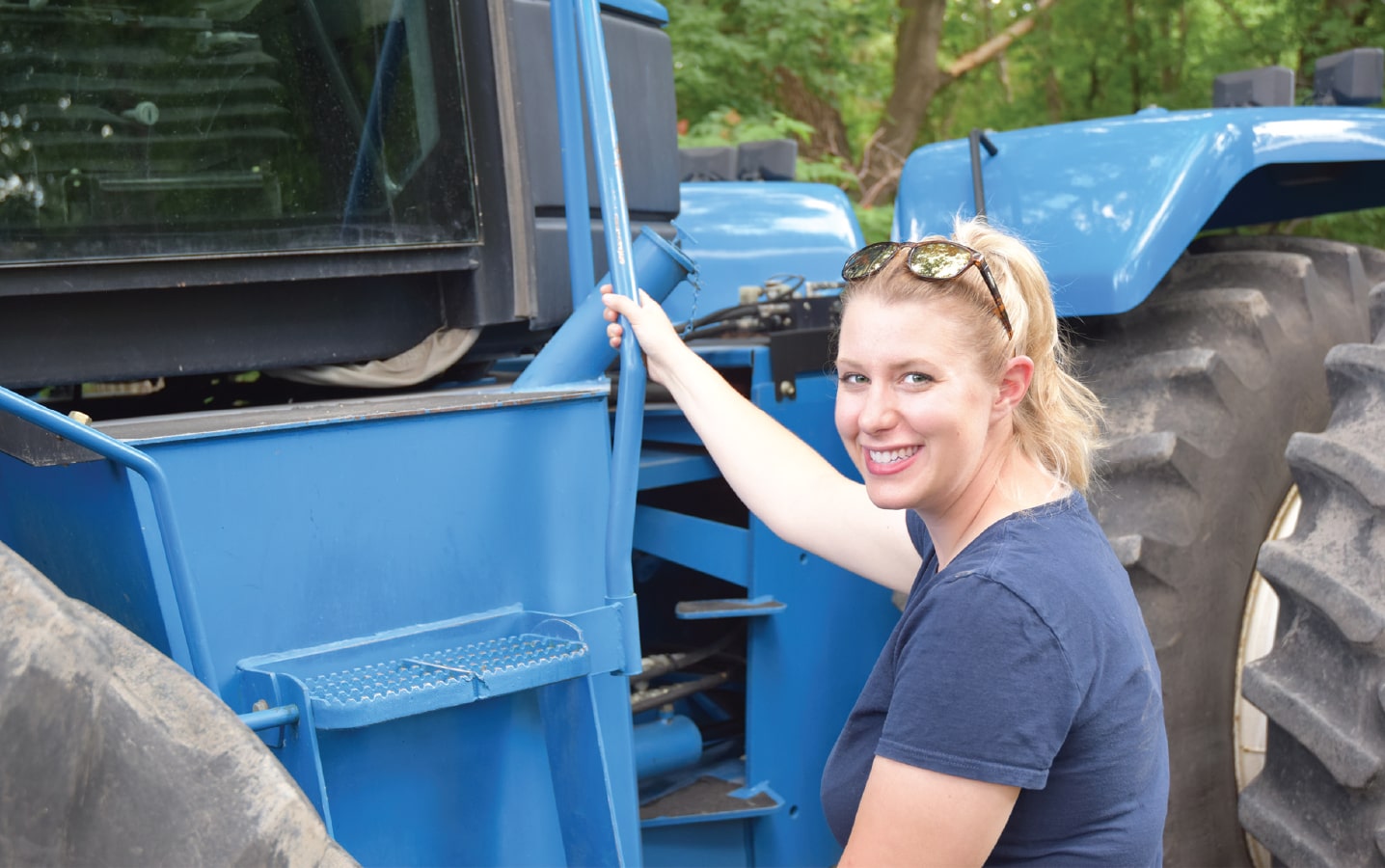Best Return on Investment
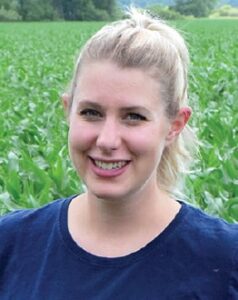
Nicolea Dow
Portage la Prairie, Manitoba
Nicolea Dow recently purchased a used Bourgault 3310 seeding tool. “The decision came from a piece of wisdom that an older farmer told my dad. That is, you only have one opportunity to seed a crop right, so make sure to do it as best as you can.”
Nicolea Dow recently bought a used Bourgault 3310 seeding tool with independently-mounted paralink openers. “The decision came from a piece of wisdom that an older farmer told my dad,” she says. “That is, you only have one opportunity to seed a crop right, so make sure to do it as best as you can.”
Whenever Dow invests in something for the farm, top of mind is, how does this make me more money? “I’d rather pull a $150,000 air seeder with a $20,000 tractor than the other way around,” she says. “I know those are low numbers, but you get the idea.”
Dow originally thought that a disc drill might be better for their lighter land. Her thinking changed after being on a panel at the Manitoba Agronomists Conference with Jeff Strukov from Bourgault. She asked Strukov, “If you farmed where I did, what would you use?” He recommended the paralink option. So, at Ag Days in Brandon in 2020, Dow and her dad went through every drill and made a final decision.
Dow says the new drill gives them a more uniform plant stand for canola and cereals. “This uniform start means we get more value from all the other applications in the field, like fungicides,” she says. With mid-row banders, the drill also puts down all fertilizer in one pass without placing high rates near the seed row.
“The three sustainability factors – profit, people and planet – are top of mind for me,” she says. “On the people front, mid-row banders help with workload because we can now do all fertilizer application in one pass at spring time. Environmentally, spring banding can reduce losses compared to fall applications and broadcast application. We put NH3 through the mid-row banders, which means we can go a longer distance on one tank fill and reduce nitrogen costs. Mid-row placement also has plant safety benefits. All of these improve profits.”

Brett Jans
New Norway, Alberta
Brett Jans upgraded the farm’s grain drying system in 2019 because the old one couldn’t keep up. “The breaking point was 2018 when we had 32,000 bushels of wheat at 22 per cent moisture. It was terrifying to think of how much grain we had to dry and the spoilage risks.”
Brett Jans’s father bought a used Vertec 250 bu./hr. dryer back in the 1990s. He set it up with 1,500-bushel bins at each end, one for wet grain and one for dry, and it provided the farm with a “reliable” system for over 20 years, Jans says. Then their area went into a wet harvest cycle starting around 2014 and the old dryer became a bottleneck.
“We were putting the majority of our grain through the dryer,” Jans says. With low capacity and small wet and dry bins, they were constantly moving grain around.
“It was like a make-work project,” Jans says. “The breaking point was 2018 when we had 32,000 bushels of wheat at 22 per cent moisture. It was terrifying to think of how much grain we had to dry and the spoilage risks.”
In 2019, they bought a Neco dryer with capacity to dry 500 to 1,000 bu./hr. and set it up with two 4,000-bushel wet bins and 11 4,000-bushel bins for dry grain storage. Grain moved from the wet bins to the dryer with a high flight conveyor and from the dryer to the dry bins on a pneumatic system that was fully automated. Western General installed the system. Natural gas fuels the dryer and Jans rents a diesel generator for two months a year to provide the required three-phase power.
Now, on a typical harvest day, they fill the wet bins plus the trucks and carts. The dryer runs all night to work through the wet bins, then first thing in the morning Jans refills the wet bins with grain from the trucks and carts. “I’m usually caught up by the time combining starts again.”
Almost all malt barley and wheat goes through the dryer, which allows them to start harvest earlier in the season and extends the harvest day. They didn’t have to dry any canola in 2020, but if it’s October and canola isn’t combined, Jans says they will combine canola at 15 per cent moisture.
“I still don’t know if the dryer is a good investment,” Jans says. “Other farmers pay the elevator to dry their grain, so they don’t have to go to the expense of an on-farm system.”
Jans says the dryer makes him “a bit of a maniac” at harvest because he’ll take some grain off “at ridiculously high moisture levels” that he might not have to deal with if he just waited a week.
He also has to “babysit” the dryer. “I haven’t had any fires, but I have had ‘smoke shows’ that require some quick action,” he says.
But the dryer can spread out harvest which, as others have said, is like having another combine. It can save grades for malt barley and wheat. And it means Jans has been able to avoid the cycle of spring harvests that lead to late seeding and then late harvests again and again.
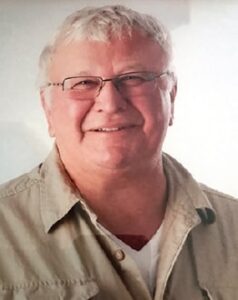
Roland Crowe
Piapot First Nation, Saskatchewan
Roland Crowe says one of best returns he had was from a Case Credit line of credit, which allowed him to buy the basic machinery he needed to farm. “I couldn’t afford downtime, so if I had a breakdown the local dealership would provide a replacement while I waited for repairs. It was a good dealership. They were extremely understanding
of me.”
Roland Crowe was chief at Piapot First Nation for a decade and was provincial chief for another decade or so. Piapot First Nation is about 50km northeast of Regina in the fertile land of the Qu’Appelle River Valley. The First Nation ran a productive farm in its early days, running a herd of 1,000 cattle and selling thousands of tonnes of grain to customers in Regina. Despite government policies that eventually restricted First Nations’ ability to sell their production off-reserve, Crowe has been a farmer most of his life. “I was a young farmer who got extremely lucky in politics,” he says.
Crowe farmed for a number of years near Avonlea on a large block of land the First Nation received in the 1980s to make good on unfulfilled treaty land entitlements. Most of that land is now rented out. “We’re in a partnership with renters to grow canola and other crops on that land,” he says. At age 78, Crowe still farms a half section of land on the Piapot primary reserve in the Qu’Appelle Valley.

A big challenge for First Nations farmers is that they don’t own the land individually, and reserve land can’t be used as collateral for a loan. This limits access to start-up and operating capital. Crowe says one of the best returns he had was from a Case Credit line of credit, which allowed him to buy the basic machinery he needed to farm. “I couldn’t afford downtime, so if I had a breakdown the local dealership would provide a replacement while I waited for repairs,” he says. “It was a good dealership. They were extremely understanding of me,” he says. He also had a line of credit for fuel from Co-op. For all other necessary crop inputs like seed, fertilizer and herbicide, he paid for with money he made from the farm the year before.
To see a greater benefit from the land, Crowe would like to see policies and programs that would make it easier for more First Nations people to farm their own land.

Lyndon Nakamura
Taber, Alberta
Nakamura Farms’ best purchase lately was a new office complex. “It may be hard to give it a dollar value, but it will improve our overall farm efficiency and people will be more team motivated. It will provide long-term gains for the farm.”
Lyndon Nakamura runs the canola business for Nakamura Farms, which grows potatoes, sweet corn, spring wheat, sunflowers, peas and hybrid seed canola under irrigation. The operation has 12 full time staff, including an agronomist and bookkeeper, and another 50 or so temporary staff during potato harvest. Nakamura says the best investment they made recently was to build a large office hub on the farm to centralize everything.
“The building has a boardroom, a lab to check potato samples and do grain grading, office spaces, locker space for staff and a proper lunch room,” Nakamura says.
They had been renting office space in town, but “it was hard to keep everything coordinated,” Nakamura says. Now everything is centralized in a 2,500 square foot building.
“This gives us a place to meet and get together as a team,” Nakamura says. “It may be hard to give it a dollar value, but it will improve our overall farm efficiency and people will be more team motivated. It will provide long-term gains for the farm.”
Internet is a little slower than it was in town, but it can still run Zoom meetings, Nakamura says. They have discussed running fibre optic from town out to the new farm office.

Codie Nagy
Ogema, Saskatchewan
Codie Nagy has four weather stations across his farm and says “the dollar value they bring for a relatively small investment is substantial.”
Codie Nagy has four weather stations across his farm and says “the dollar value they bring for a relatively small investment is substantial.”
The stations measure temperature, rainfall, relative humidity, wind, and soil moisture. The latter is a key feature for Nagy. The probe goes 100cm into the soil, providing moisture measurements at 10cm increments through the soil profile. The station computer uses this information to estimate the crop’s water-driven yield potential (WDYP).
Weather stations go in after seeding, so Nagy seeded 30 acres really early this year so he could place the probe and use the results to make final decisions on fertilizer rates across the farm.
“Snowfall had been low, so we were going into spring not sure what we were up against,” he says. “The probe said the field had potential for above average yield if it received average rainfall. So we didn’t cut fertilizer rates.”
Then, after a good rain during May long weekend, the probes increased the WDYP so Nagy decided to add more fertilizer as a top dress, using the sprayer with stream bar nozzles. “The original yield target for canola was 50 bu./ac. With the rain, we increased the target by seven to 10 bu./ac. and added about 30 per cent more nitrogen.”
The farm’s average canola yield is 42-43 bu./ac., but certain fields have the ability to yield over 60 bu./ac. with good moisture conditions, Nagy says.
All of Nagy’s probes are from South Country Equipment, with probe information available through the Crop Intelligence app. A new feature is a leaf wetness sensor, which Nagy can use to make decisions on fungicide applications for sclerotinia stem rot in canola and fusarium head blight in wheat.
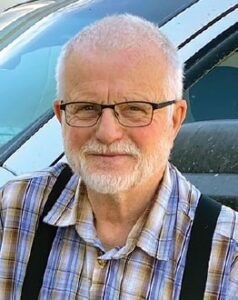
Leonard Waldner
Lauder, Manitoba
Maple Grove Colony bought and rebuilt a 30-foot Case IH Concord disc drill last winter. (See the image.) “It is one of the best purchases we’ve made lately.”
The farm bought and rebuilt a used Case IH Concord 30-foot disc drill over the winter. “It is one of the best purchases we’ve made lately,” says Leonard Waldner, farm manager at Maple Grove Colony.
They seeded about half of their canola with their rebuilt disc drill this year, which has 7.5-inch row spacing. Waldner says the small drill works nicely in the corners around each irrigation pivot. They also used it rejuvenate 640 acres of long-term alfalfa stands, with the discs cutting nicely into standing crop. “The fields are so sandy, we actually reseed alfalfa when it’s raining to improve seed placement and get it off to a good start,” Waldner says.
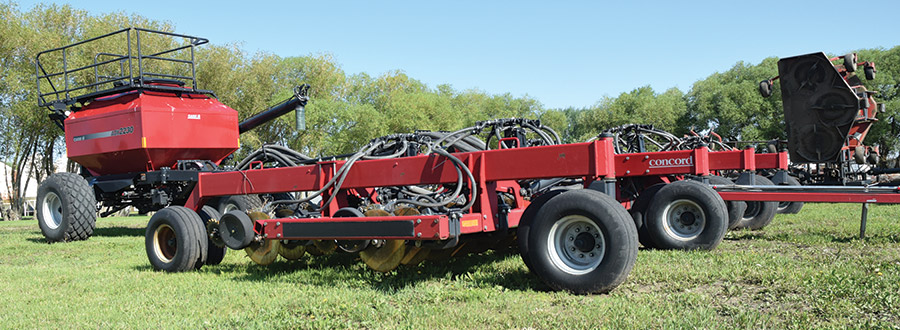
The 30-foot disc drill is their second seeding tool. Their primary tool is a 60-foot Great Plains planter with a central tank system and 15-inch spacing. The planter puts in about 1,000 acres of corn each year as well as soybeans. This year, they used it for the other half of the canola. All crops are direct seeded.
“You have to watch that you don’t have too much air, but the planter can seed canola at 2.5 lb./ac.,” Waldner says. It also improves seed spacing down each row. “Even if you have one inch between each seed, the plants don’t have to fight each other, and six to 10 inches is even better,” he says. “The plants have a big stem and don’t blow over.”
With dry conditions so far in 2021 (this interview was done in late June), their canola has struggled to achieve ground cover, Waldner says.





